Financial Reporting Report: Assessment of Concepts and Applications
VerifiedAdded on 2020/12/24
|6
|1464
|186
Report
AI Summary
This report provides a comprehensive analysis of financial reporting, focusing on the assessment of concepts and assumptions within the conceptual framework established by the IASB. The report delves into the fundamental and enhancing qualitative characteristics, such as relevance, faithful representation, comparability, verifiability, timeliness, and understandability, illustrating their impact on financial statements. It further explores the application of these concepts to offer quality information to stakeholders, covering topics like recognition, measurement, and disclosure. The report also examines the basic assumptions of financial reporting, including economic entities, going concern, monetary unit, periodicity, and accrual basis, providing real-world examples to clarify their practical implications. The conclusion emphasizes the importance of adhering to these principles to enhance the reliability and usefulness of financial reporting.

FINANCIAL REPORTING
Paraphrase This Document
Need a fresh take? Get an instant paraphrase of this document with our AI Paraphraser
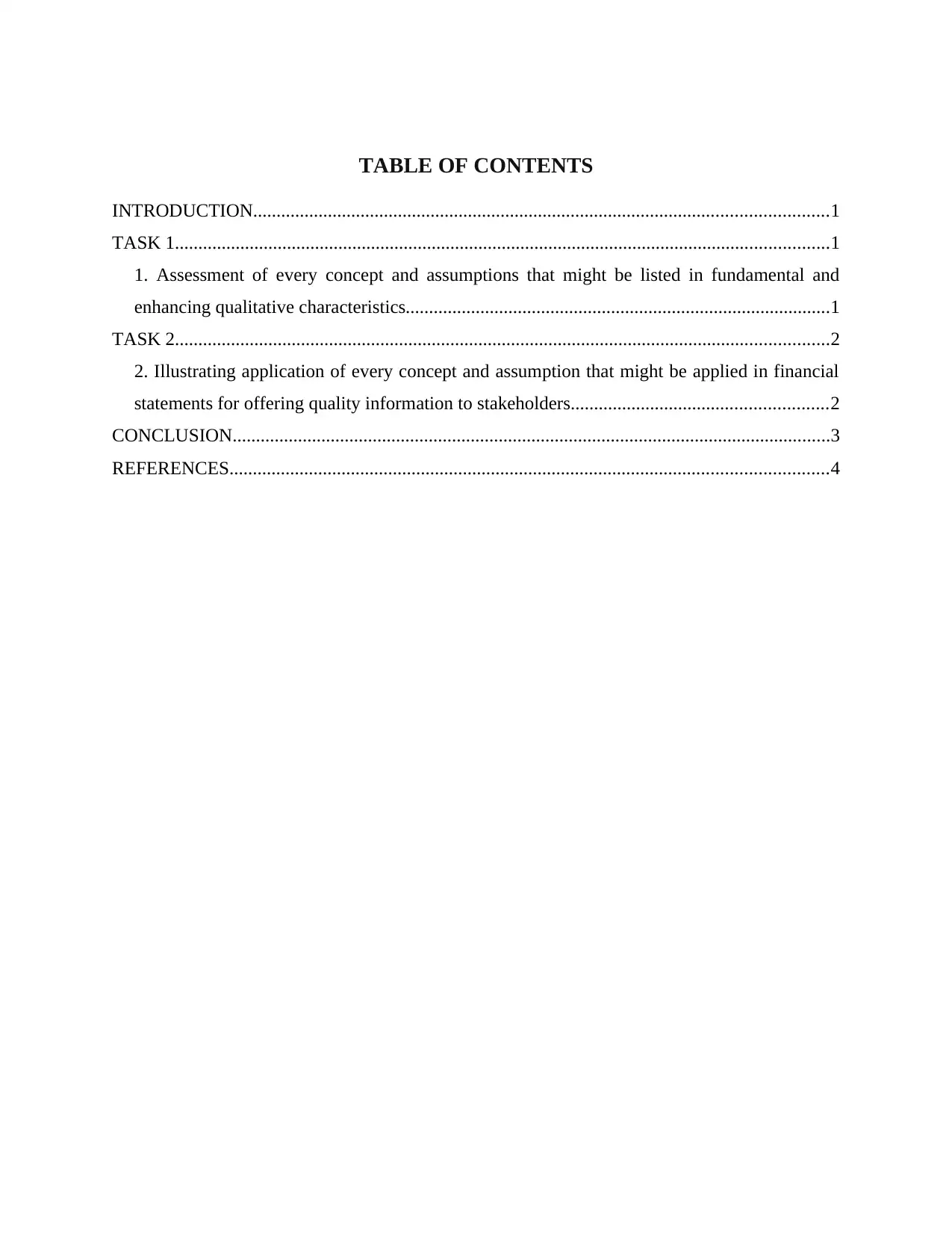
TABLE OF CONTENTS
INTRODUCTION...........................................................................................................................1
TASK 1............................................................................................................................................1
1. Assessment of every concept and assumptions that might be listed in fundamental and
enhancing qualitative characteristics...........................................................................................1
TASK 2............................................................................................................................................2
2. Illustrating application of every concept and assumption that might be applied in financial
statements for offering quality information to stakeholders.......................................................2
CONCLUSION................................................................................................................................3
REFERENCES................................................................................................................................4
INTRODUCTION...........................................................................................................................1
TASK 1............................................................................................................................................1
1. Assessment of every concept and assumptions that might be listed in fundamental and
enhancing qualitative characteristics...........................................................................................1
TASK 2............................................................................................................................................2
2. Illustrating application of every concept and assumption that might be applied in financial
statements for offering quality information to stakeholders.......................................................2
CONCLUSION................................................................................................................................3
REFERENCES................................................................................................................................4
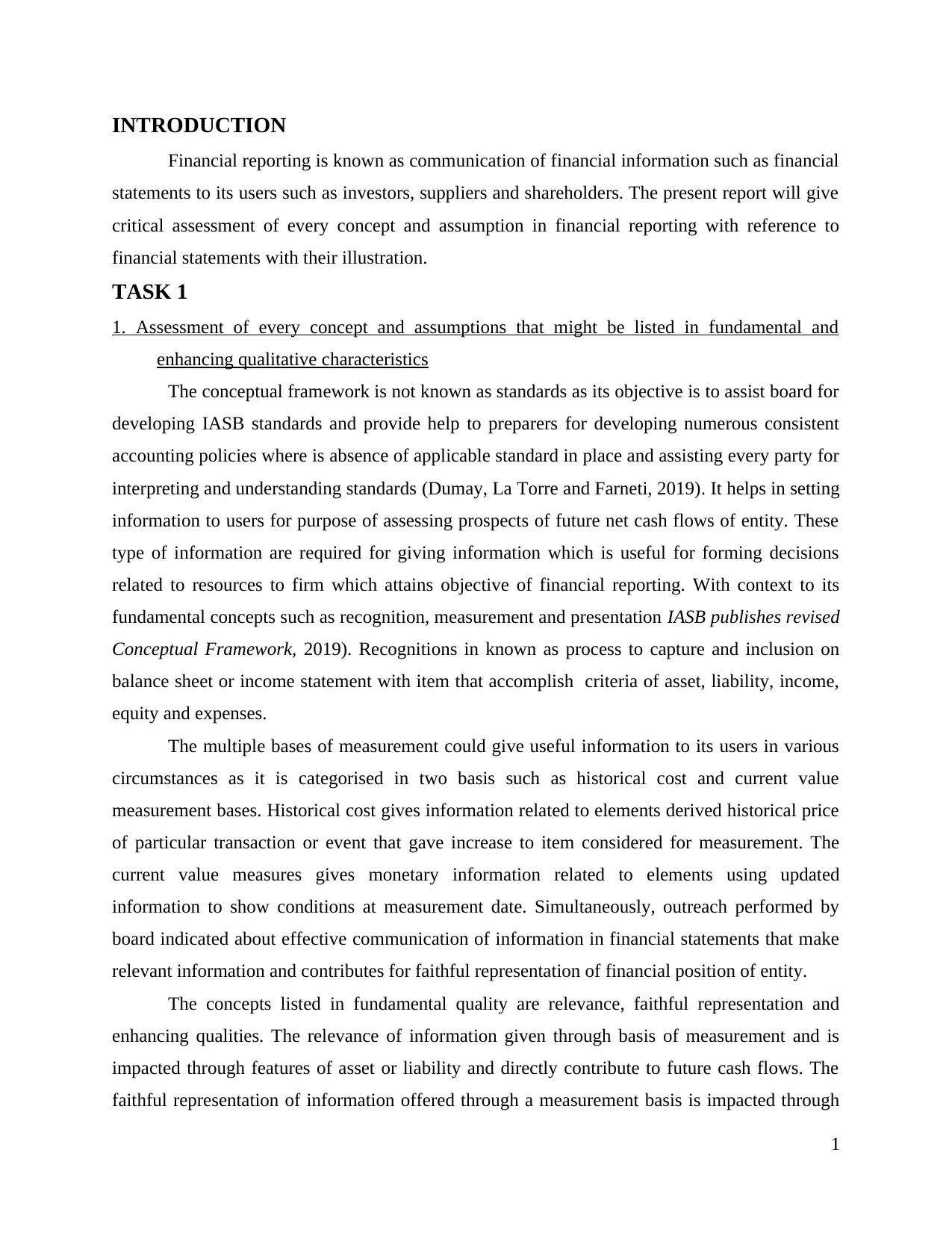
INTRODUCTION
Financial reporting is known as communication of financial information such as financial
statements to its users such as investors, suppliers and shareholders. The present report will give
critical assessment of every concept and assumption in financial reporting with reference to
financial statements with their illustration.
TASK 1
1. Assessment of every concept and assumptions that might be listed in fundamental and
enhancing qualitative characteristics
The conceptual framework is not known as standards as its objective is to assist board for
developing IASB standards and provide help to preparers for developing numerous consistent
accounting policies where is absence of applicable standard in place and assisting every party for
interpreting and understanding standards (Dumay, La Torre and Farneti, 2019). It helps in setting
information to users for purpose of assessing prospects of future net cash flows of entity. These
type of information are required for giving information which is useful for forming decisions
related to resources to firm which attains objective of financial reporting. With context to its
fundamental concepts such as recognition, measurement and presentation IASB publishes revised
Conceptual Framework, 2019). Recognitions in known as process to capture and inclusion on
balance sheet or income statement with item that accomplish criteria of asset, liability, income,
equity and expenses.
The multiple bases of measurement could give useful information to its users in various
circumstances as it is categorised in two basis such as historical cost and current value
measurement bases. Historical cost gives information related to elements derived historical price
of particular transaction or event that gave increase to item considered for measurement. The
current value measures gives monetary information related to elements using updated
information to show conditions at measurement date. Simultaneously, outreach performed by
board indicated about effective communication of information in financial statements that make
relevant information and contributes for faithful representation of financial position of entity.
The concepts listed in fundamental quality are relevance, faithful representation and
enhancing qualities. The relevance of information given through basis of measurement and is
impacted through features of asset or liability and directly contribute to future cash flows. The
faithful representation of information offered through a measurement basis is impacted through
1
Financial reporting is known as communication of financial information such as financial
statements to its users such as investors, suppliers and shareholders. The present report will give
critical assessment of every concept and assumption in financial reporting with reference to
financial statements with their illustration.
TASK 1
1. Assessment of every concept and assumptions that might be listed in fundamental and
enhancing qualitative characteristics
The conceptual framework is not known as standards as its objective is to assist board for
developing IASB standards and provide help to preparers for developing numerous consistent
accounting policies where is absence of applicable standard in place and assisting every party for
interpreting and understanding standards (Dumay, La Torre and Farneti, 2019). It helps in setting
information to users for purpose of assessing prospects of future net cash flows of entity. These
type of information are required for giving information which is useful for forming decisions
related to resources to firm which attains objective of financial reporting. With context to its
fundamental concepts such as recognition, measurement and presentation IASB publishes revised
Conceptual Framework, 2019). Recognitions in known as process to capture and inclusion on
balance sheet or income statement with item that accomplish criteria of asset, liability, income,
equity and expenses.
The multiple bases of measurement could give useful information to its users in various
circumstances as it is categorised in two basis such as historical cost and current value
measurement bases. Historical cost gives information related to elements derived historical price
of particular transaction or event that gave increase to item considered for measurement. The
current value measures gives monetary information related to elements using updated
information to show conditions at measurement date. Simultaneously, outreach performed by
board indicated about effective communication of information in financial statements that make
relevant information and contributes for faithful representation of financial position of entity.
The concepts listed in fundamental quality are relevance, faithful representation and
enhancing qualities. The relevance of information given through basis of measurement and is
impacted through features of asset or liability and directly contribute to future cash flows. The
faithful representation of information offered through a measurement basis is impacted through
1
⊘ This is a preview!⊘
Do you want full access?
Subscribe today to unlock all pages.

Trusted by 1+ million students worldwide
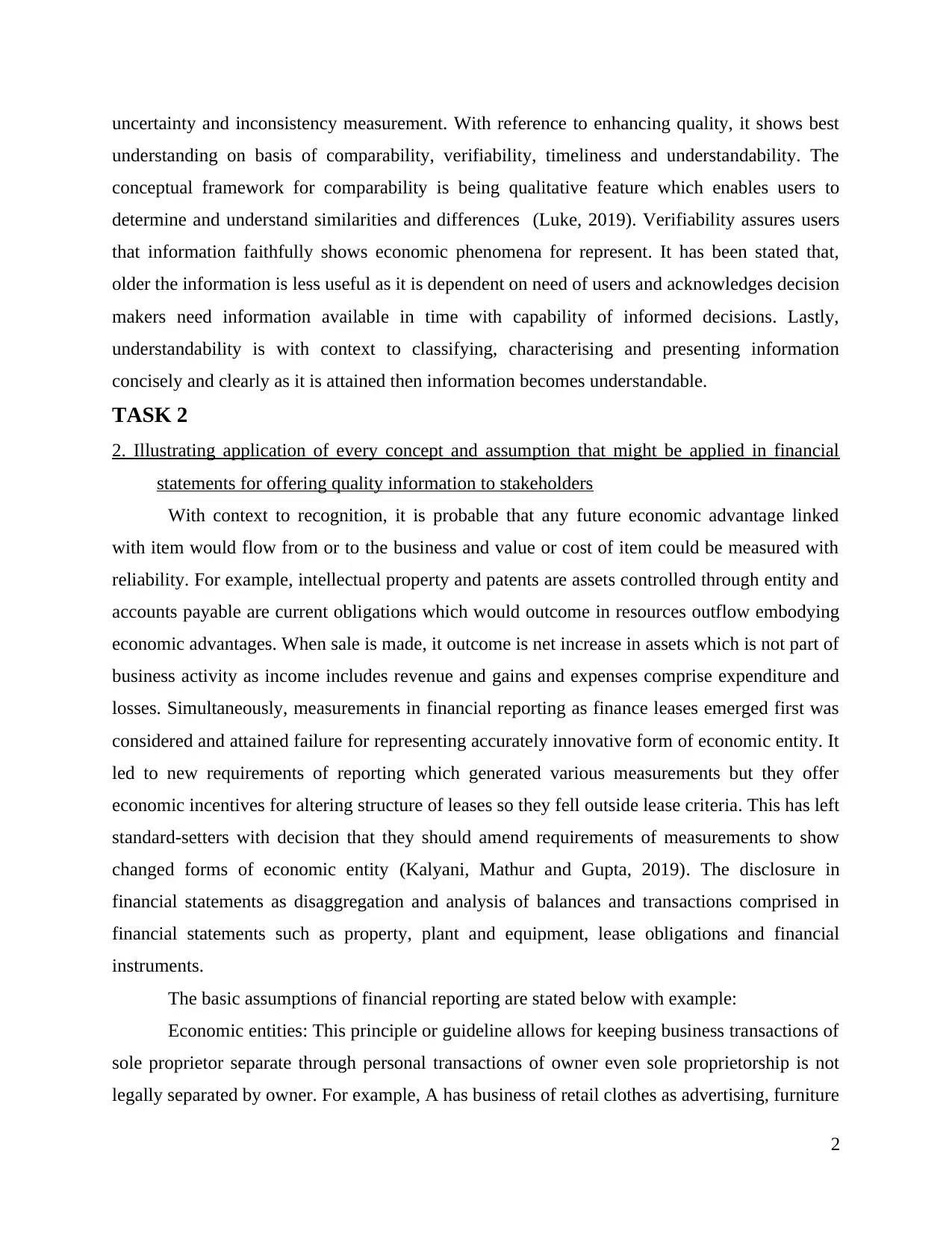
uncertainty and inconsistency measurement. With reference to enhancing quality, it shows best
understanding on basis of comparability, verifiability, timeliness and understandability. The
conceptual framework for comparability is being qualitative feature which enables users to
determine and understand similarities and differences (Luke, 2019). Verifiability assures users
that information faithfully shows economic phenomena for represent. It has been stated that,
older the information is less useful as it is dependent on need of users and acknowledges decision
makers need information available in time with capability of informed decisions. Lastly,
understandability is with context to classifying, characterising and presenting information
concisely and clearly as it is attained then information becomes understandable.
TASK 2
2. Illustrating application of every concept and assumption that might be applied in financial
statements for offering quality information to stakeholders
With context to recognition, it is probable that any future economic advantage linked
with item would flow from or to the business and value or cost of item could be measured with
reliability. For example, intellectual property and patents are assets controlled through entity and
accounts payable are current obligations which would outcome in resources outflow embodying
economic advantages. When sale is made, it outcome is net increase in assets which is not part of
business activity as income includes revenue and gains and expenses comprise expenditure and
losses. Simultaneously, measurements in financial reporting as finance leases emerged first was
considered and attained failure for representing accurately innovative form of economic entity. It
led to new requirements of reporting which generated various measurements but they offer
economic incentives for altering structure of leases so they fell outside lease criteria. This has left
standard-setters with decision that they should amend requirements of measurements to show
changed forms of economic entity (Kalyani, Mathur and Gupta, 2019). The disclosure in
financial statements as disaggregation and analysis of balances and transactions comprised in
financial statements such as property, plant and equipment, lease obligations and financial
instruments.
The basic assumptions of financial reporting are stated below with example:
Economic entities: This principle or guideline allows for keeping business transactions of
sole proprietor separate through personal transactions of owner even sole proprietorship is not
legally separated by owner. For example, A has business of retail clothes as advertising, furniture
2
understanding on basis of comparability, verifiability, timeliness and understandability. The
conceptual framework for comparability is being qualitative feature which enables users to
determine and understand similarities and differences (Luke, 2019). Verifiability assures users
that information faithfully shows economic phenomena for represent. It has been stated that,
older the information is less useful as it is dependent on need of users and acknowledges decision
makers need information available in time with capability of informed decisions. Lastly,
understandability is with context to classifying, characterising and presenting information
concisely and clearly as it is attained then information becomes understandable.
TASK 2
2. Illustrating application of every concept and assumption that might be applied in financial
statements for offering quality information to stakeholders
With context to recognition, it is probable that any future economic advantage linked
with item would flow from or to the business and value or cost of item could be measured with
reliability. For example, intellectual property and patents are assets controlled through entity and
accounts payable are current obligations which would outcome in resources outflow embodying
economic advantages. When sale is made, it outcome is net increase in assets which is not part of
business activity as income includes revenue and gains and expenses comprise expenditure and
losses. Simultaneously, measurements in financial reporting as finance leases emerged first was
considered and attained failure for representing accurately innovative form of economic entity. It
led to new requirements of reporting which generated various measurements but they offer
economic incentives for altering structure of leases so they fell outside lease criteria. This has left
standard-setters with decision that they should amend requirements of measurements to show
changed forms of economic entity (Kalyani, Mathur and Gupta, 2019). The disclosure in
financial statements as disaggregation and analysis of balances and transactions comprised in
financial statements such as property, plant and equipment, lease obligations and financial
instruments.
The basic assumptions of financial reporting are stated below with example:
Economic entities: This principle or guideline allows for keeping business transactions of
sole proprietor separate through personal transactions of owner even sole proprietorship is not
legally separated by owner. For example, A has business of retail clothes as advertising, furniture
2
Paraphrase This Document
Need a fresh take? Get an instant paraphrase of this document with our AI Paraphraser
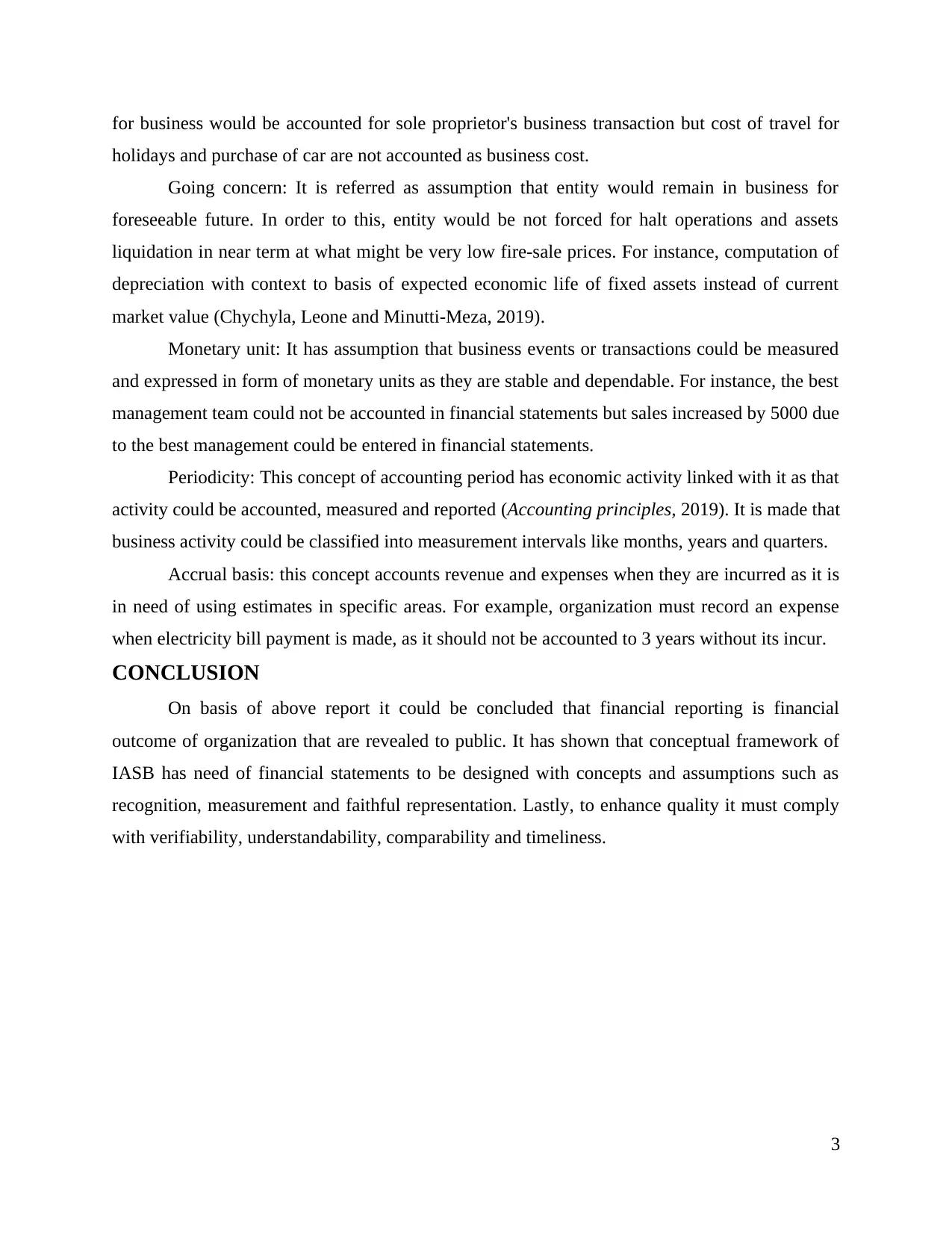
for business would be accounted for sole proprietor's business transaction but cost of travel for
holidays and purchase of car are not accounted as business cost.
Going concern: It is referred as assumption that entity would remain in business for
foreseeable future. In order to this, entity would be not forced for halt operations and assets
liquidation in near term at what might be very low fire-sale prices. For instance, computation of
depreciation with context to basis of expected economic life of fixed assets instead of current
market value (Chychyla, Leone and Minutti-Meza, 2019).
Monetary unit: It has assumption that business events or transactions could be measured
and expressed in form of monetary units as they are stable and dependable. For instance, the best
management team could not be accounted in financial statements but sales increased by 5000 due
to the best management could be entered in financial statements.
Periodicity: This concept of accounting period has economic activity linked with it as that
activity could be accounted, measured and reported (Accounting principles, 2019). It is made that
business activity could be classified into measurement intervals like months, years and quarters.
Accrual basis: this concept accounts revenue and expenses when they are incurred as it is
in need of using estimates in specific areas. For example, organization must record an expense
when electricity bill payment is made, as it should not be accounted to 3 years without its incur.
CONCLUSION
On basis of above report it could be concluded that financial reporting is financial
outcome of organization that are revealed to public. It has shown that conceptual framework of
IASB has need of financial statements to be designed with concepts and assumptions such as
recognition, measurement and faithful representation. Lastly, to enhance quality it must comply
with verifiability, understandability, comparability and timeliness.
3
holidays and purchase of car are not accounted as business cost.
Going concern: It is referred as assumption that entity would remain in business for
foreseeable future. In order to this, entity would be not forced for halt operations and assets
liquidation in near term at what might be very low fire-sale prices. For instance, computation of
depreciation with context to basis of expected economic life of fixed assets instead of current
market value (Chychyla, Leone and Minutti-Meza, 2019).
Monetary unit: It has assumption that business events or transactions could be measured
and expressed in form of monetary units as they are stable and dependable. For instance, the best
management team could not be accounted in financial statements but sales increased by 5000 due
to the best management could be entered in financial statements.
Periodicity: This concept of accounting period has economic activity linked with it as that
activity could be accounted, measured and reported (Accounting principles, 2019). It is made that
business activity could be classified into measurement intervals like months, years and quarters.
Accrual basis: this concept accounts revenue and expenses when they are incurred as it is
in need of using estimates in specific areas. For example, organization must record an expense
when electricity bill payment is made, as it should not be accounted to 3 years without its incur.
CONCLUSION
On basis of above report it could be concluded that financial reporting is financial
outcome of organization that are revealed to public. It has shown that conceptual framework of
IASB has need of financial statements to be designed with concepts and assumptions such as
recognition, measurement and faithful representation. Lastly, to enhance quality it must comply
with verifiability, understandability, comparability and timeliness.
3
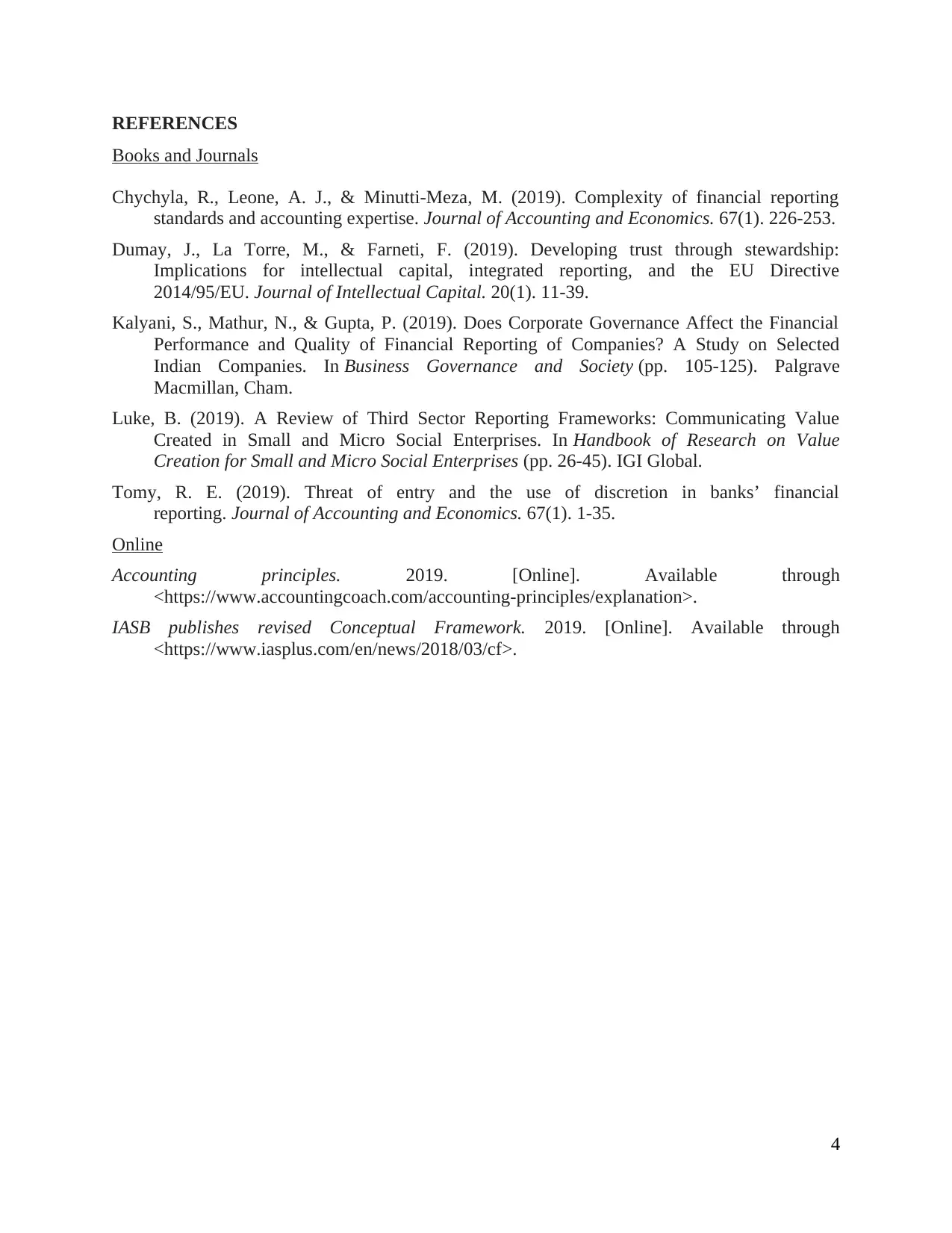
REFERENCES
Books and Journals
Chychyla, R., Leone, A. J., & Minutti-Meza, M. (2019). Complexity of financial reporting
standards and accounting expertise. Journal of Accounting and Economics. 67(1). 226-253.
Dumay, J., La Torre, M., & Farneti, F. (2019). Developing trust through stewardship:
Implications for intellectual capital, integrated reporting, and the EU Directive
2014/95/EU. Journal of Intellectual Capital. 20(1). 11-39.
Kalyani, S., Mathur, N., & Gupta, P. (2019). Does Corporate Governance Affect the Financial
Performance and Quality of Financial Reporting of Companies? A Study on Selected
Indian Companies. In Business Governance and Society (pp. 105-125). Palgrave
Macmillan, Cham.
Luke, B. (2019). A Review of Third Sector Reporting Frameworks: Communicating Value
Created in Small and Micro Social Enterprises. In Handbook of Research on Value
Creation for Small and Micro Social Enterprises (pp. 26-45). IGI Global.
Tomy, R. E. (2019). Threat of entry and the use of discretion in banks’ financial
reporting. Journal of Accounting and Economics. 67(1). 1-35.
Online
Accounting principles. 2019. [Online]. Available through
<https://www.accountingcoach.com/accounting-principles/explanation>.
IASB publishes revised Conceptual Framework. 2019. [Online]. Available through
<https://www.iasplus.com/en/news/2018/03/cf>.
4
Books and Journals
Chychyla, R., Leone, A. J., & Minutti-Meza, M. (2019). Complexity of financial reporting
standards and accounting expertise. Journal of Accounting and Economics. 67(1). 226-253.
Dumay, J., La Torre, M., & Farneti, F. (2019). Developing trust through stewardship:
Implications for intellectual capital, integrated reporting, and the EU Directive
2014/95/EU. Journal of Intellectual Capital. 20(1). 11-39.
Kalyani, S., Mathur, N., & Gupta, P. (2019). Does Corporate Governance Affect the Financial
Performance and Quality of Financial Reporting of Companies? A Study on Selected
Indian Companies. In Business Governance and Society (pp. 105-125). Palgrave
Macmillan, Cham.
Luke, B. (2019). A Review of Third Sector Reporting Frameworks: Communicating Value
Created in Small and Micro Social Enterprises. In Handbook of Research on Value
Creation for Small and Micro Social Enterprises (pp. 26-45). IGI Global.
Tomy, R. E. (2019). Threat of entry and the use of discretion in banks’ financial
reporting. Journal of Accounting and Economics. 67(1). 1-35.
Online
Accounting principles. 2019. [Online]. Available through
<https://www.accountingcoach.com/accounting-principles/explanation>.
IASB publishes revised Conceptual Framework. 2019. [Online]. Available through
<https://www.iasplus.com/en/news/2018/03/cf>.
4
⊘ This is a preview!⊘
Do you want full access?
Subscribe today to unlock all pages.

Trusted by 1+ million students worldwide
1 out of 6
Related Documents
Your All-in-One AI-Powered Toolkit for Academic Success.
+13062052269
info@desklib.com
Available 24*7 on WhatsApp / Email
![[object Object]](/_next/static/media/star-bottom.7253800d.svg)
Unlock your academic potential
Copyright © 2020–2025 A2Z Services. All Rights Reserved. Developed and managed by ZUCOL.





